Dell 2707WFP: Looking for the Middle Ground of Large LCDs
by Jarred Walton on April 4, 2007 10:00 AM EST- Posted in
- Displays
Brightness and Contrast Ratio
For those that need accurate colors, hardware color calibration is basically a given. Here, we report scores for the same areas as we did on the previous page, only this time the results are taken after we have used Monaco Optix XR Pro to calibrate the display.
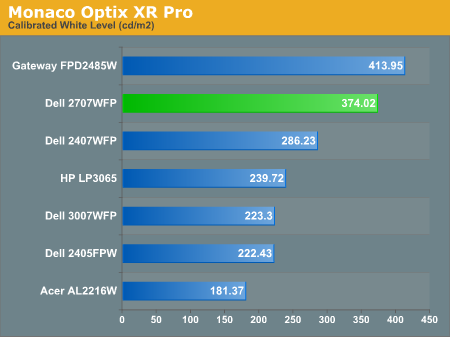
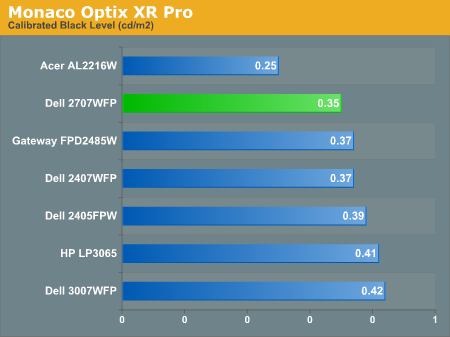
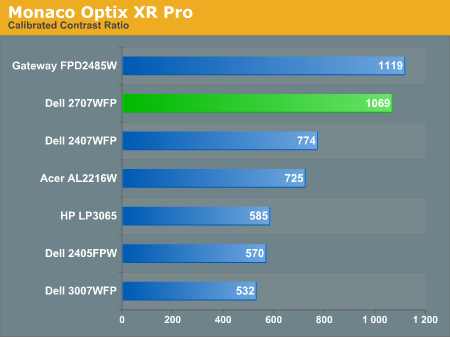
The most significant changes from calibration come in the area of brightness, where all of the displays end up running at less than their maximum brightness. You can of course choose to run a display at a higher than recommended brightness level, and the ambient lighting in a room will also determine what brightness setting is best. Our testing was performed indoors with a moderate amount of lighting, and the displays were adjusted according to directions. We also found that manually reducing the brightness level to something more reasonable (like 200-300 cd/m2) did not significantly affect the results on any of these displays, so consider the above charts as more of a maximum recommended brightness for each particular LCD.
Color Accuracy
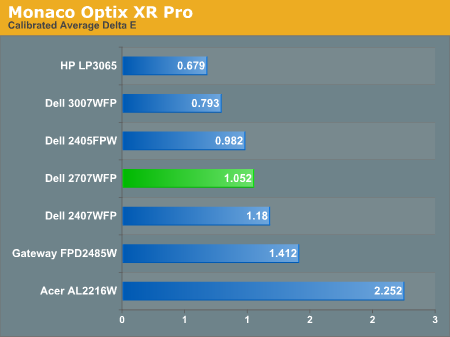
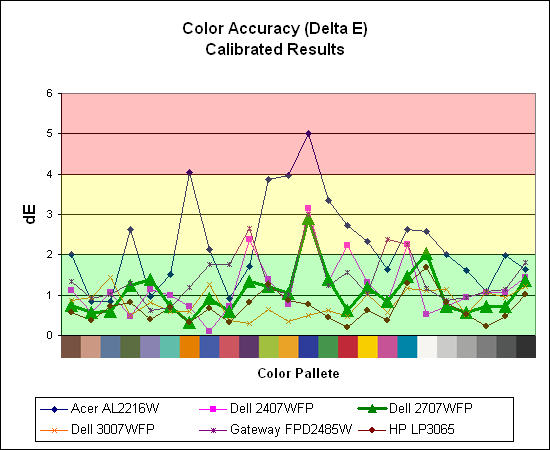
The 2707WFP's uncalibrated results were quite poor, but calibration helps it improve drastically. A few colors show a bit of a spike (dark blue and bright white), but the majority of the color results are very close to the "perfect" range and certainly acceptable for the vast majority of users. Both of the 30" displays are at the top of the charts, and it's likely that their S-IPS panels are simply better overall at providing accurate colors (post-calibration). Note also how all of the S-PVA have very similar curves, including a nearly identical spike on dark blue.
For those that need accurate colors, hardware color calibration is basically a given. Here, we report scores for the same areas as we did on the previous page, only this time the results are taken after we have used Monaco Optix XR Pro to calibrate the display.



The most significant changes from calibration come in the area of brightness, where all of the displays end up running at less than their maximum brightness. You can of course choose to run a display at a higher than recommended brightness level, and the ambient lighting in a room will also determine what brightness setting is best. Our testing was performed indoors with a moderate amount of lighting, and the displays were adjusted according to directions. We also found that manually reducing the brightness level to something more reasonable (like 200-300 cd/m2) did not significantly affect the results on any of these displays, so consider the above charts as more of a maximum recommended brightness for each particular LCD.
Color Accuracy


The 2707WFP's uncalibrated results were quite poor, but calibration helps it improve drastically. A few colors show a bit of a spike (dark blue and bright white), but the majority of the color results are very close to the "perfect" range and certainly acceptable for the vast majority of users. Both of the 30" displays are at the top of the charts, and it's likely that their S-IPS panels are simply better overall at providing accurate colors (post-calibration). Note also how all of the S-PVA have very similar curves, including a nearly identical spike on dark blue.










39 Comments
View All Comments
JarredWalton - Wednesday, April 4, 2007 - link
A perfect example of stuff that doesn't look right with a higher DPI setting is anything that uses a bitmap. All of the icons at 120dpi tend to look like crud in XP. There are just far too many areas of Windows and the applications that run on it that are built around pixel sizes, so changing DPI settings only sort of affects them.Anyway, the point isn't whether or not higher DPI is good or bad. You like it, others don't. That's the main idea behind that introduction: an explanation of why higher pixel pitch can be a good thing. I really do have poor vision (an irregular astigmatism that can't be corrected without a retina transplant, so I live with slight double vision). I find many of the high DPI screens to be undesirable, although I do like higher resolutions for image work.
kalrith - Wednesday, April 4, 2007 - link
Since we're discussing pixel pitch and poor eyesight, I thought I'd mention that one of my coworkers has such poor vision that he's using a 21" LCD at 800x600 resolution and thinks it's "just right".Also, out of the 10 19" LCDs we have, only one person runs hers at the native res. Everyone else uses 1024x768.
LoneWolf15 - Thursday, April 5, 2007 - link
This is one reason why I "downgraded" (the rest of the specs are similar, other than that I also shaved 2 pounds of weight) from a laptop with a 15" 1600x1200 UXGA display to a 14" 1024x768 XGA display. At 15", picture detail was incredible, but text for web browsing was giving me sore eyes and headaches. I wouldn't mind having 1280x1024 at 14" or 15", but since I'm not paying for it, beggars can't be choosers.It's also why I returned my Dell 2007WFP and exchanged it for a 2407WFP. Higher resolution, but larger pixel pitch as well.
kmmatney - Wednesday, April 4, 2007 - link
I'm another person who likes big pixels. Work tried to give me a 17" LCD, but I would have none of that. I then tried a 21" Samsung at 1600 x 1200, but it was still too small. Now I have a 20" LCD running native at 1400 x 1050 and its really nice. I have a laptop with small pixels that I use when I travel, but I'm much more productive when I can see everything clearly.I would love to have this display, but it really needs to come down in price.
strikeback03 - Wednesday, April 4, 2007 - link
my vision is awful uncorrected - way beyond not being able to see the big "E". But since I'm always wearing glasses or contacts anyway I like high-DPI displays. Love my thinkpad with the SXGA 15" display. The UXGA 15" would probably be hard to read though.My boss has a ~20" CRT that he runs at either 800x600 or 1024x768.
jc44 - Wednesday, April 4, 2007 - link
OK - I admit it - I'm stunned. With the exception of your colleague with the poor eyesight I find it hard to conceive how anyone would prefer (presumably) a slightly fuzzy (due to scaling artifacts) 1024x768 to a sharp 1280x1024 on a 19" LCD. I could simply not put enough information on the screen to be able to do my job at that resolution without resorting to a lot of printouts.Well horses for courses I guess - thanks
JC
xsilver - Friday, April 6, 2007 - link
lol - the amount of people that have their lcd monitors set to non native resolutions is insanely funny.but even more insanely funny is how many people say they cant see anything wrong with the scaling artifacts and fuzziness.
I haven't done much (any) testing on this in gaming though - is the distortion just as bad in gaming when running a non native res? getting a 20" lcd or above these days has pretty much required a high end graphics card to be purchased if any gaming wants to be done if you want to run native res.
still prefer crt atm myself but I realize it will be inevitable that i'll have to make the switch and need to figure out some options.
mitchell123 - Thursday, December 3, 2009 - link
hello FriendsThios is a nice article.......for everyone...........
==============
Mitchell
Tommyguns - Wednesday, April 4, 2007 - link
19" Viewsonic lcd here. you guessed it. 1024x768 and it suits me just fine. not that i have bad eyes at age 22 or anything, i just like being able to clearly see everything. I game hard as well and it works out just fine. i do have it in clone mode going to an aux 17inch crt thats about 20 feet away. higher res. is nice, but i prefer big letters, with out the squints sometimes.it would be nice to know what is around average in terms of gpu's, to be able to use these larger lcd's. average wasnt always a super highend 8xxx series card.